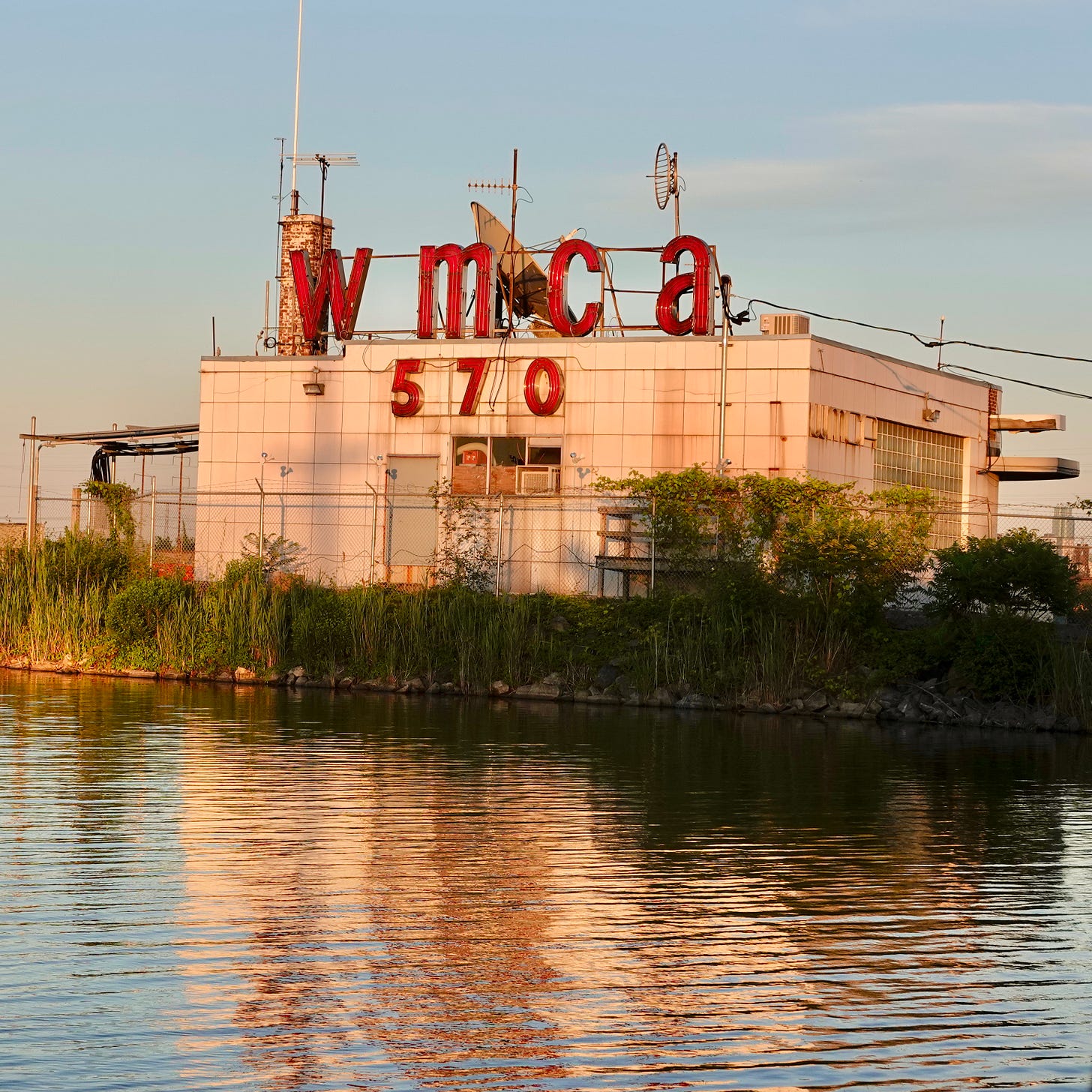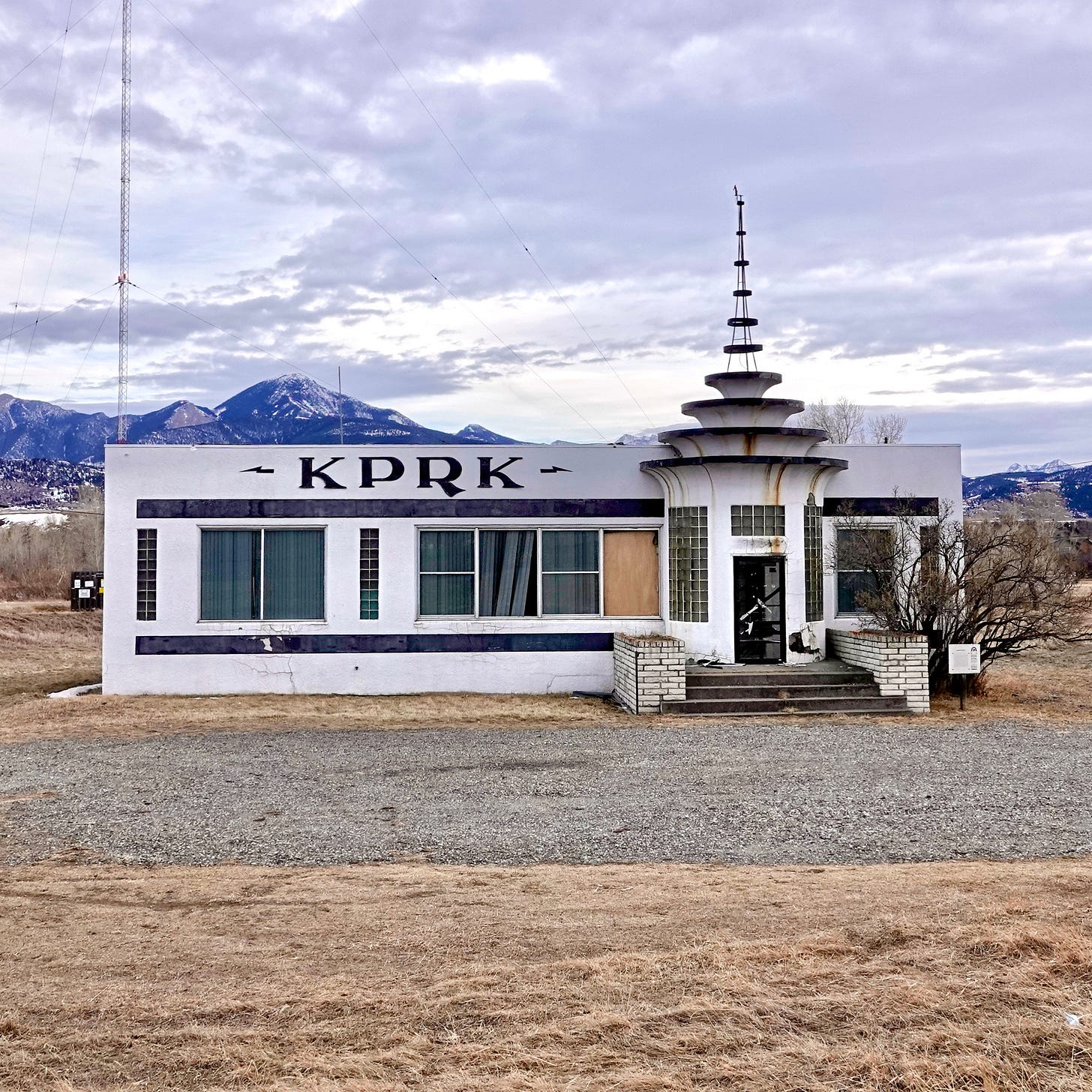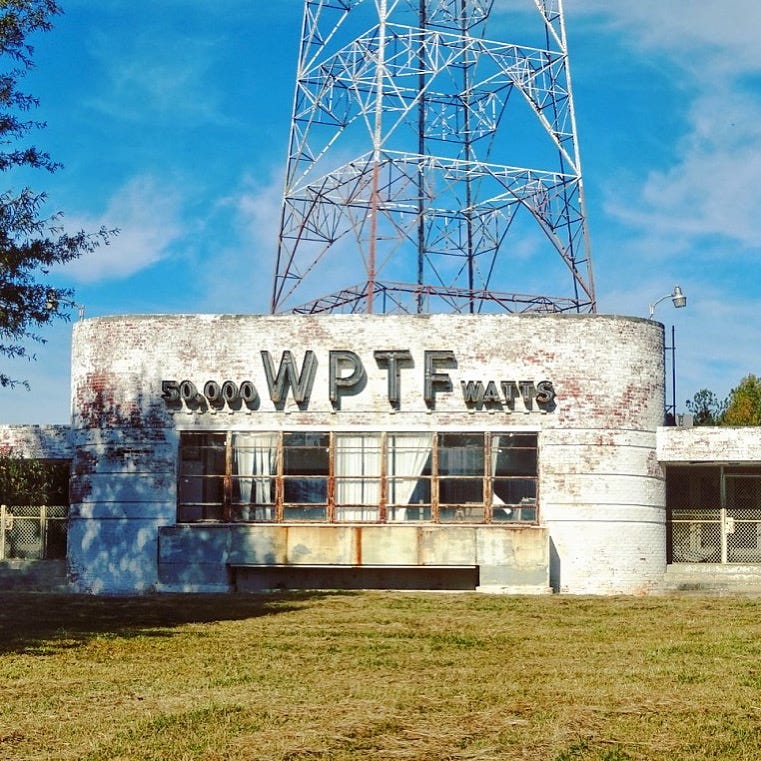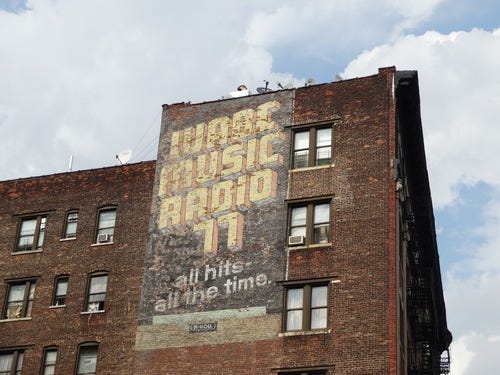It's National Radio Day! Here are 3 visually jolting transmitter buildings -- plus one ghost sign -- to celebrate the occasion
It’s National Radio Day, a fine day to share three of my favorite transmitter buildings I’ve had the pleasure to photograph.
Here are my essays on each, along with a few extras for your enjoyment of these very special buildings.
Do you have a favorite radio (or TV) building? Please let me know in the comments. (I’ve photographed a great many more TV buildings, and will be doing a roundup of those soon.)
1.). KPRK, LIVINGSTON, MONTANA
This radio station building in Livingston, Montana, could have just been a squat hut, a concrete box, nothing fancy. One can imagine an architect being intimidated by that mountain range, and conceding there was no point in competing with nature’s own designs. Or a general manager, launching a radio station just after World War II, reluctant to spend on form, when function is what pays the bills.
But fortunately, we didn’t have those problems when this Art Moderne masterpiece was built for the newly launched KPRK Radio. Missoula architect William Fox created something so captivating, this building sits on the National Register of Historic Places. When it was added to this list in 1979, it was still a tad young, and the Department of the Interior defended the inclusion of this “belated” example of Moderne because the design was so unusual for the area and was so well preserved.
Even in its infancy, KPRK was already a throwback to the Hollywood of the 1930s, the faux broadcast tower and black lightning bolts flanking the call letters like something out of a “Flash Gordon” serial. Yes, it was a throwback to happier times before World War II.
But happy days were here again. General manager Walter Carle and owner Paul McAdam were right here on January 9, 1947, when KPRK went on the air.
According to the Montana Historical Society, the futuristic style of the building was meant to contrast with the traditional brick buildings in Livingston, a fantastic town with some extraordinary neon, and some awfully nice people I enjoyed getting to know. (I even met a very friendly horse here, trotting down the sidewalk.)
But that was back in town. Here, on the outskirts, I was all alone. There was nobody in the building to shoo me away. AM 1340 is still on the air, but no longer operates from here. Somebody should do something about that boarded-up window, and make sure this gem finds some wonderful new use.
Seventy-six years young, this beauty still puts on a splendid show at the foot of the mountains. KPRK was a revelation then, is certainly that now, and will remain that, hopefully forever. [MAP]
2.) WMCA, KEARNY, NEW JERSEY

When WMCA-AM was building its stunning Art Deco transmission facility in 1940 in a New Jersey salt marsh, construction workers dug up petrified tree stumps.
The discovery of the “prehistoric relics” was reported by the New York Daily News, and the fossils were dispatched to the American Museum of Natural History for examination.
To know this wild slice of shoreline in Kearny is to believe that this is exactly the sort of place where you might dig up ancient traces of life on Earth.It’s so wild here that it’s impossible to get a clean photo of this architectural jewel from Belleville Turnpike, the road that slices through the marsh.
There is a menacing barrier of tall reeds, prickly bushes and weeds to penetrate, and then you are confronted with the water’s slippery edge. To take this photo, I was dangling on the edge of the shore, grabbing a tree with one hand and my camera with another.
Had it fallen, the marsh would have claimed it, left to be found by construction workers millions of years from now.
The last time I went for this shot, the light was not as nice and my position was not as fortuitous. My arm was even jabbed by an inconsiderate reed. This time, I came prepared with long sleeves, the setting sun at my back and the same determination to bushwack my way to this shot.
This building, glimpsed from the New Jersey Turnpike, has fascinated me since I was a kid.WMCA was a New York radio powerhouse, a pioneering AM station that embraced Top 40 and talk formats before most others.
The station dates to 1925, its call letters a nod to its first home -- the Hotel McAlpin in Herald Square (note the first three letters). In 1940, AM 570 began beaming its 5,000 watts toward NYC, where it was a top station in the 1960s and brought Beatlemania to the masses.
By 1970, with FM ascendant and archnemesis WABC ever stronger, WMCA went all talk. By 1989, WMCA switched to religious programming.But its 1960s heyday under the DJs known as "The Good Guys" still captivates.
All those memories emanated from this gorgeous hut, itself now a fossil from the early days of broadcasting in America. [
NOTE: This is a dangerous photo to get, from parking on the side of the road to positioning yourself on the water’s edge. Proceed with caution. [MAP]
RELATED: HERE’S A PEEK INSIDE
3.) WPTF, RALEIGH, NORTH CAROLINA
If I lived in Raleigh, North Carolina, I would listen to WPTF radio just because of this Art Deco transmitter building, and I don’t have to be anywhere near Raleigh, given that powerhouse 50,000-watt transmitter. (As a Class B station, however, its reach is dampened at night to protect the reception on other 50,000-watt AM 680s in North America, but it still packs some punch.)
Let’s take a moment to salute the invention of the wireless and all it has contributed to our culture. The WPTF transmitter is on busy U.S. 1 just outside Raleigh. But while all those watts mean it’s easy to dial in the station, the compact marvel of the transmitter building is hard to reach.
As I did back in 2016, I had to park across the street, play Frogger in traffic, cross railroad tracks and power through a prickly barrier of bushes to take in this view. It’s worth the trouble, though, as you can plainly see.
The building inside is an accidental museum of broadcast history, teeming with old turntables and other long-discarded technology, practically abandoned except for the maintenance visits from engineers who keep the daytime transmitter properly juiced.
I love how the neon on the facade proudly trumpets the station and its reach. This beauty had me reaching for my camera -- and, out of curiosity, the radio dial on my car’s dashboard. The call letters stand for “We Protect The Family,” a slogan for a life insurance company that once owned the station. I just hope this building is always protected.
NOTE: Just like WMCA, this is not an easy building to photograph. Proceed with caution! [MAP]
RELATED: TAKE A TOUR INSIDE!
EXTRA! Ghost sign for WABC Radio!
Musicradio 77 WABC: All hits – all the time!
If you’ve lived in New York long enough, or have at least an awareness of 20th century radio history, then this brand means something to you.
You can hear that PAMS jingle – 77 WABC! – that is a delightful little earworm. It’s part of the culture, obligatory background noise in a movie set in New York in the 1960s or 1970s.
Indeed, even movies that were filmed in that era knew the value of the jingle: You can hear it in a scene from “Midnight Cowboy,” that 1969 flick that captures New York on the cusp of that decade that so fascinates us, that seems so remote to today’s New York: the 1970s.
So it is extraordinary when we find something from that era that somehow has escaped New York’s relentless instinct to erase the old, erect the new – rinse and repeat.
I refer to the beautiful image above – this massive mural in Hamilton Heights that — until being covered up by a new building several years ago — still promoted Musicradio 77 WABC.
Now, the station still exists – except for the Musicradio part of course. Way back in 1982, executives made the fateful, if prescient, decision to switch formats to all talk after 22 years as a music station.
Today’s gabfest can be traced back to that fateful day – May 10, 1982 – when WABC made the format switch.
That day is remembered bitterly by many New Yorkers who grew up with AM popular music as the “Day the Music Died.” This was the station of Cousin Brucie, Dan Ingram and other golden voices, of the Beatles and the great pantheon of 1960s and 70s pop music.
It was certainly unusual for an advertising space in so prominent a location (just south of West 145th Street, on St. Nicholas Avenue) to remain frozen in time, not collecting a dime as it promotes a defunct product – for decades.
This ghost sign lingered so long, it was up longer that the Musicradio 77 format was even on the air. It was sort of a museum exhibit on indefinite loan from curators unknown, an important relic of a time and place not only in New York, but in the story of how we listen to popular music.
It turns out, alas, that it was not on permanent loan.









Growing up in Pittsburgh in the 80’s we would pass the WIXZ station building on Route 30 in East McKeesport on our way to my grandparents house in the eastern suburbs. This was where the station was located not the transmitter. Always struck me that a radio station would be located in such an insignificant looking building. By the way, in the 70’s, WIXZ McKeesport, was home to a DJ who went by the name of “Bachelor” Jeff Christie. Bachelor Jeff would go on to gain fame as Rush Limbaugh.
The former WEEI transmitter building in Medford MA was a classic -- it's still there, but I read that the iconic art deco curved glass block feature has been covered up. Also, the call is now WEZE. WEEI moved up the dial from 590 to 850 years ago after a merger.
Those who enjoy reading about transmitter/tower sites will enjoy Scott Fybush's work. Check out the "Tower of the Week" feature. https://www.fybush.com/